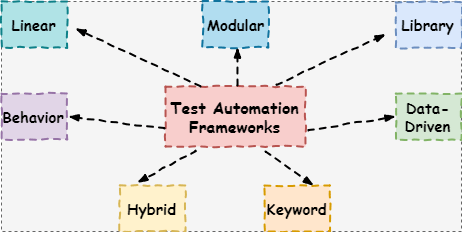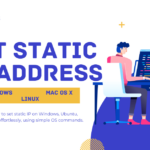Test automation frameworks play a significant role in Agile and help in speed up the testing process. Their continuous usage decreases maintenance costs and manual test efforts. If used efficiently, they can provide an attractive return on investment (ROI) for testing teams working in the agile model.
This post intends to educate you on the different kinds of automation frameworks available today. For software testers, who are new to automation testing, or those who wish to refresh their knowledge, this post will give crisp and precise information on the time-tested approaches used by professionals.
Test Automation Frameworks – A Guide to The Basics
Before we dig into the details of frameworks and their advantages, let’s understand what a test automation framework means.

What is a Test Framework?
An automation testing framework is a combination of many things such as:
- The guidelines or rules used for creating and designing test cases.
- Tools or Components designed to help testing professionals validate more efficiently.
You can relate these guidelines to coding standards, test-data management methods, object repositories, reporting schemes, or mechanisms to read external resources.
None of these are mandatory to use, and the testers can write scripts or capture tests without binding to them. Using a framework provides many benefits in terms of better speed and quality.
What do you gain from test automation frameworks?
It will boost a team’s testing velocity and efficiency, enhance test precision, and decrease maintenance costs and chances of risks. They are vital to an effective automated testing process for a few main goals:
- Better test efficiency
- Less maintenance
- Reduce manual tasks
- Improve test coverage
- Reusability of test and code
Usually, every software development team tends to perform early testing to minimize risks, and automation testing frameworks work as a catalyst to do it more efficiently.
Must Read – 200+ Selenium Interview Questions
Types of Test Automation Frameworks
Over the last 20 years, various automation models surfaced, each with their respective architecture and distinct pros & cons. However, you should be able to understand them so that you can make the right decision about which of them to choose as per your test requirements.
- LAT – Linear Automation Test Framework
- MBT – Modular-Based Test Framework
- LibAT – Library Architecture Test Framework
- DDT – Data-Driven Test Framework
- KDT – Keyword-Driven Test Framework
- HTF – Hybrid Test Framework
- BDD – Behavior-Driven Development Framework
Linear Automation Test Framework
It is one of the primitive types of a framework that presents a record-and-playback approach. In this, there is no need to create scripts or write steps. Everything happens in sequential order. The tester only has to capture every test step such as browsing, providing inputs, enforcing checks, etc. Once he recorded a scenario, he can play the script and carry out the testing.
Pros:
- Zero scripting or coding efforts
- Automatic script generation and exceptional time-saving
- Sequential execution brings higher visibility and comfort
- Most tools support a record-and-playback feature, so with a little R&D, you can choose a suitable one.
Cons:
- Auto-generated scripts lack reusability
- Tight coupling with the test data
- You can’t run multiple test cases with different sets of inputs.
- Maintenance is high as a small change can require a lot of effort.
- Not a scalable model if the testing scope expands.
Modular-Based Test Framework
This framework proposes to split the application under test (AUT) into different units, modules, or sections. It requires testers to validate each part in isolation.
Once the application’s logical separation is completed, a test script for each unit gets devised and later merged to perform comprehensive testing. The merging process results in the creation of various test cases.
Pros:
- If the application changes, then only the related script needs to be updated.
- Changes have a low impact on the overall testing.
- By reusing the scripts, it is easy to produce new test cases.
Cons:
- The scripts use a fixed set of test data, so you can’t integrate multiple data sets.
- Scripting or coding skills are mandatory to use this approach.
Library Architecture Test Framework
It derives its seeds from the modular framework. However, it has some added advantages.
Unlike the MBT, you don’t need to write individual scripts for each unit of the application. Instead, you expand them by creating tasks and combining them with functions. It anyway gets the software into relevant pieces.
You then group functions in the form of libraries. The test scripts reuse it to formulate new test cases.
Pros:
- Unlike MBT, it provides a high level of modularity.
- Test maintenance is simple and scalability is possible.
- The function library is a highly reusable component used by multiple test scripts.
Cons:
- It also has a dependency on the fixed set of test data.
- Coding, as well as product knowledge, are essential for writing scripts and functions.
- Test scripts take more time to develop.
Data-Driven Test Framework
It was the first test framework that addressed the use of multiple data sets. It gave the ability to separate the input data from script logic.
Testers now could solve their long-lived problem of using hard-coded test data. They could now design test cases that require execution multiple times with different input data. In such cases, fixed input doesn’t work, and it was the primary limitation of the earlier testing frameworks.
This framework makes it flexible for testers to store and send the input/ output values to test scripts from data sources, such as Text, CSV, Excel, and different databases. Test scripts can access the inputs at any point in time depending upon the need.
Pros:
- Provided support for multiple data sets
- The same case runs with different input data and hence reduces the test count.
- No hard coding of test data
- More test coverage as multiple inputs can test all possible code branches.
Cons:
- Need expert and experienced testers to utilize this framework design.
- Selection of external data source and code to receive input from it
- A full-fledged setup requires more time to work correctly.
Keyword-Driven Test Framework
This framework emphasizes defining keywords, link data, and actions for the application under test.
It requires testers to lay out a table that would have keywords, input, and the action for tests to run.
In the data-driven framework approach, the data doesn’t appear within the script. However, it is a step further from any of the previous methods.
In this approach, you maintain a table of keywords and procure them in an external table. This way, you can make them independent from the testing tool. These keywords become part of the script and perform various actions being to test the application features. You can name them as Navigate, Enter, or Click, etc.
Once a table is available, the testers can start writing the code to perform actions based on the keywords. During execution, the script reads the test data, resolves the keyword-action mapping, and runs the test.
Pros:
- You don’t need an expert to write scripts.
- The different scripts can point to the same keyword and hence reuse the code.
- Test scripts don’t change as the application changes. It’s the data that changes.
Cons:
- It brings a high cost.
- It is time-consuming and complicated.
- Extra work to define keywords and set up the table
- People with niche skills are needed.
- Scaling leads to more effort.
Hybrid Test Framework
Subsequent frameworks borrowed or adopted the positive points of their predecessors. And the hybrid test framework is no exception.
It is a mixture of some of the previously described frameworks. The idea was to leverage the features of some and relinquish the flaws of others.
Every software is unique, and so are the methods devised to test them. Since more teams are shifting to Agile now, hence more is a need for a flexible framework for automated testing.
A hybrid test framework promises more features and has fewer complications.
Behavior-Driven Development Framework
The idea of such a framework is to provide a platform that enables everyone such as product owners, developers, and testers to contribute to automation.
The success of it depends on how well the dev and test members collaborate. It doesn’t bind to a programming language, so a person without such skills can add test cases.
It proposes to use a non-technical, universal language to write test scenarios. Some tools like Cucumber and JBehave are available freely to begin Behavior Driven Development.
Do check out – Manual Testing Tutorial
Best,
TechBeamers







